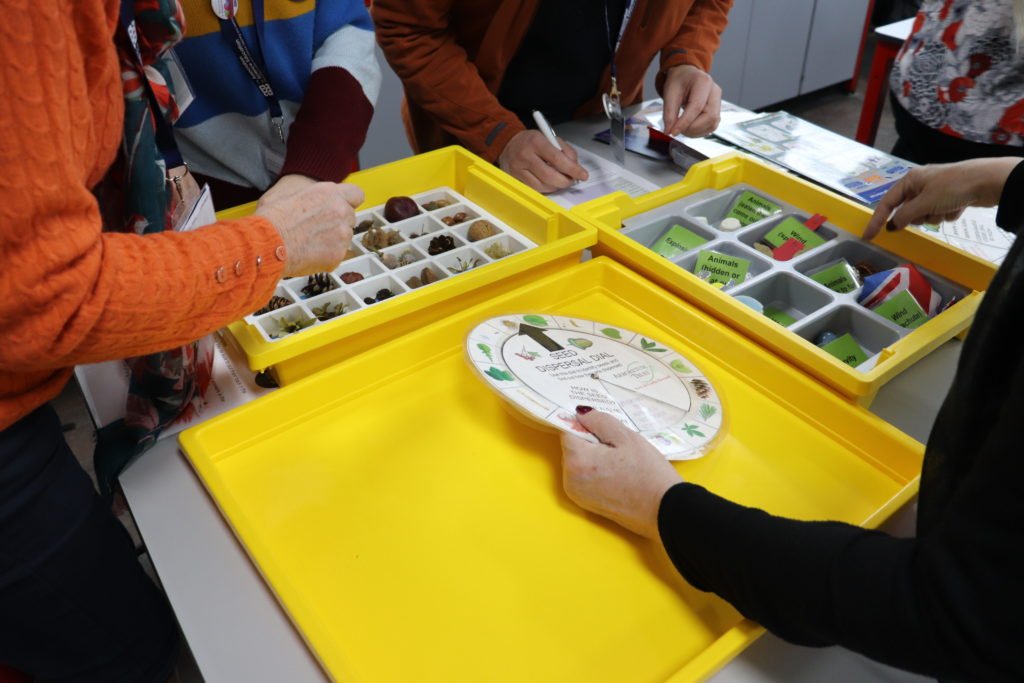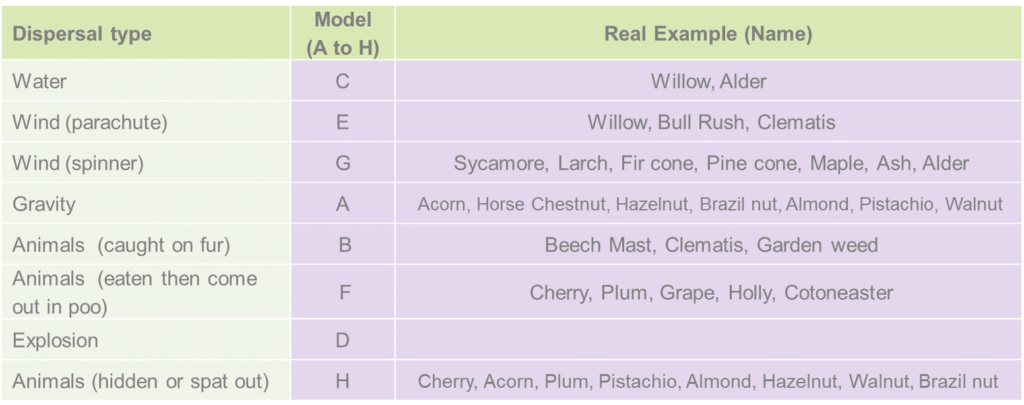Seed tray
This activity was created as part of a Gratnells What’s in my tray? CPD workshop for primary and secondary science teachers and technicians to support practical work and delivery of the curriculum. It can be carried out as a stand-alone activity for students or combined with other activities from the session to form a STEM carousel. If you would like to find out more about running this activity as part of a carousel, take a look at the CPD Workshops section of the Gratnells Learning Room website where you will find further details and example carousels.

Explore seed models and real examples, learn seed names and methods of dispersal. This activity was inspired by the Seed Dispersal activity in ‘Here’s my topic…where’s my science’ Book 2 by Lesley Hunter for the Primary Science Teaching Trust and further informed by Gratnells Learning Rooms & STEM Consultant, Dr Katherine Forsey’s previous work leading outdoor learning at the Yorkshire Arboretum.
Learning outcomes
You will be able to:
- Name the primary methods of seed dispersal.
- Name and identify a selection of real seeds.
- Successfully identify the dispersal methods of a selection of real seeds.
You will need (per group of 4):
- 1 x Gratnells Art tray
- 2 x Shallow Gratnells (F1) tray with lids
- 1 x 8 section Gratnells tray insert
- 1 x 30 section Gratnells tray insert
- A wide variety of seeds collected from trees, plants or common fruits g. dandelion seed head, cleavers (a.k.a sticky weed or robin-run-the-hedge), sycamore helicopters, maple helicopters, acorn, hornbeam seeds, conker, pine cone, larch cone, alder cones, ash keys, Caucasian wingnuts, beech nuts/mast, avocado seed, peach stones, eucalyptus seed pods, burdock seeds, clematis seeds, apple pips, pear pips, silver birch catkins, willow catkins, lime tree seeds, sweet chestnuts, hazelnuts, walnuts, raw almonds, pecan nuts, monkey nuts (peanuts in their cases), pistachios in their shells, holly berries*, elder berries*, rosehips, blackberries/brambles, seeded grapes*, cherries* or cherry stones, plum* or plum stones, sloes*, cypress/conifer balls, rowan berries*, Gorse bush seed pods, pea family seed pods (Leguminosae) (* are fresh and would need to be obtained or collected close to the time of the activity or frozen to preserve them until needed)
- A key to the seeds collected (blank template provided)
- One model to represent each of the eight types of seed dispersal methods labelled A to H
- 1 x Set of seed dispersal type cards
- 1 x Set of 30-section tray insert 1-30 section labels
- 1 x Set of the seed dispersal type cards.
- 2 x Home-made seed dispersal guides or a Gatekeeper seed dispersal guide
- One set of seed dispersal type cards
- A pre-printed answer sheetor a blank piece of paper and a pen/pencil
Tip: Collect seeds all year round to build up your collection. Many of the seeds can be stored long-term once collected and used again and again, just be sure to dry them thoroughly before storage to avoid rot/mould. The fruits are perishable, many could be picked up in small quantities from a local greengrocer to avoid being left with a large surplus or the seeds could be removed and dried. Berries can be frozen until required if not available fresh when needed.
This activity also works for individuals or smaller teams, just increase the amount of time allocated to complete it. Once prepared, this activity can be repeated multiple times, reusing the same equipment for each team.
Preparation:
- Print, cut out and laminate (optional) one set of the seed dispersal type cards.
- Print, cut out and laminate (optional) one set of the 30-section tray insert 1-30 section labels and place into the bottom of each section of the 30-section tray insert.
- Print one copy of the answer sheet per participating team.
- Collect and organise the seeds into the labelled 30-section tray insert placed inside the shallow Gratnells (F1) tray.
- Make and print one copy of the seed ID key.
- Make one model of each type of seed dispersal method, label each model A to H, and place each in to its own section of the 8-section tray insert (you could ask your students to do this as a separate activity).
- Print and laminate (optional) one copy of the activity instructions.
- Put the answer sheet, key, instructions, seed dispersal type cards and ID guides into the Art tray.
What to do:
- Approach the trays and lift the lids.
- Explore the seed models and real-life seed examples.
- If you remove the real seeds or models from their tray, be sure to put them back in the same section.
- Work in the art tray to stop any of your seeds from dispersing.
- Look at the real seeds key (green table) to find the name of each seed.
- Place each seed dispersal method card on its matching seed model, write your answers in the first column of the table on the answer sheet using letters A to H.
- Take a photograph to evidence your work.
- For each dispersal method, identify one real seed example. Write your answer in the second column of the answer sheet using the seed’s name e.g. Acorn. There may be more than one correct answer for each dispersal type. There may not be a real example provided for each type of dispersal method.
- Take a photograph to evidence your work.
Tidy up time:
- Return all models and seeds to their original tray and tray insert section.
- Replace the lids, instructions, labels and guides and leave everything tidy for the next team.
When all participants/teams have completed the activity, swap answers with the next team and mark the answers. The activity leader will share the correct answers.
Example answers:
Will need to be edited to match your models and real seeds. Template answer sheet provided.

What is happening?
Seed dispersal is the method that plants use to transport their seeds away from themselves (the parent plant). If all the seeds a plant produced landed underneath the parent plant, they may not have enough resources (nutrients, light, water) to grow and develop successfully. Each method of seed dispersal represents a way plants have evolved to spread their seeds effectively to give them the best possible opportunity to grow and survive. This activity picks out eight common seed dispersal methods; water, wind (parachute and spinner), gravity, explosion and animals (stick to fur, eaten them come out in poo, hidden or spat out). Plants can have primary and secondary dispersal methods. For example, an Oak tree’s acorns often fall to the floor and roll away because of gravity (primary method), they can then be picked up from the ground, taken further away and hidden by squirrels (secondary method). They could also be stripped directly from the branch by the squirrel (primary method). Primary and secondary methods simply indicate the order in which the dispersal happens.
Other things to try…
- For younger or lower ability students, choose common and more easily recognisable seeds. For older or higher ability students, choose a wider variety of seeds and include some that are less recognisable.
- Explore the seeds, discuss and predict the different ways they might be dispersed before revealing and discussing each of the seed dispersal type cards.
- If writing the name of the seeds in the answer table is too challenging, the number of the section the seed came from could be used instead or the seeds could be matched to their dispersal type labels and a photograph taken.
- Simplify the activity by grouping the two types of wind dispersal under one heading of ‘wind’ and the different types of animal dispersal under one heading of ‘animal’.
- Add further challenge by adding in additional or secondary types of seed dispersal, for example ‘carried away by animals and buried’, which either happens when animals collect fallen seeds and nuts that have already been dispersed by gravity or when animals pick them directly from the tree or bush, e.g. acorns. Or, ‘regurgitation by animals’ where seeds do not pass fully through the animal’s digestive tract, they either regurgitate, spit or drop the seeds. Dung beetles may roll seeds away when they make balls from the poo of animals that originally ate the seeds, dispersing them further.
- Research the types of animals that perform seed dispersal including mammals, reptiles, fish and insects. Write a report on one type of plant and its seed dispersal mechanisms.
- Go on a seed safari to collect your own seeds, be sure to take a Gratnells tray with a 30 section insert to collect your finds as you go and print out a blank key sheet to record their names. Repeat at different times of year to see the effect of seasonal change. The Woodland Trust Nature Detectives has free fruit and seeds ID resources you can download to your tablet or print to take outside with you.
- Make your own model seeds to represent each type of seed dispersal and test your models to see which are most effective in terms of dispersal distance (quantitative investigation of dispersal mechanisms).
- Set a homework to look for different examples of seeds in the supermarket or gardens at home.
- Share your photographs on social media using #WhatsInMyTray.
Health & Safety
As with all Gratnells Learning Rooms What’s in my tray? activities, you should carry out your own risk assessment prior to undertaking any of the activities or demonstrations. In particular, allergies and small object choking hazards should be considered.


